NVIDIA’s GeForce GTX Titan Review, Part 2: Titan's Performance Unveiled
by Ryan Smith & Rahul Garg on February 21, 2013 9:00 AM ESTPower, Temperature, & Noise
Last but certainly not least, we have our obligatory look at power, temperature, and noise. Next to price and performance of course, these are some of the most important aspects of a GPU, due in large part to the impact of noise. All things considered, a loud card is undesirable unless there’s a sufficiently good reason to ignore the noise.
It’s for that reason that GPU manufacturers also seek to keep power usage down, and under normal circumstances there’s a pretty clear relationship between power consumption, heat generated, and the amount of noise the fans will generate to remove that heat. At the same time however this is an area that NVIDIA is focusing on for Titan, as a premium product means they can use premium materials, going above and beyond what more traditional plastic cards can do for noise dampening.
| GeForce GTX Titan Voltages | ||||
| Titan Max Boost | Titan Base | Titan Idle | ||
| 1.1625v | 1.012v | 0.875v | ||
Stopping quickly to take a look at voltages, Titan’s peak stock voltage is at 1.162v, which correlates to its highest speed bin of 992MHz. As the clockspeeds go farther down these voltages drop, to a load low of 0.95v at 744MHz. This ends up being a bit less than the GTX 680 and most other desktop Kepler cards, which go up just a bit higher to 1.175v. Since NVIDIA is classifying 1.175v as an “overvoltage” on Titan, it looks like GK110 isn’t going to be quite as tolerant of voltages as GK104 was.
| GeForce GTX Titan Average Clockspeeds | |||
| Max Boost Clock | 992MHz | ||
| DiRT:S | 992MHz | ||
| Shogun 2 | 966MHz | ||
| Hitman | 992MHz | ||
| Sleeping Dogs | 966MHz | ||
| Crysis | 992MHz | ||
| Far Cry 3 | 979MHz | ||
| Battlefield 3 | 992MHz | ||
| Civilization V | 979MHz | ||
One thing we quickly notice about Titan is that thanks to GPU Boost 2 and the shift from what was primarily a power based boost system to a temperature based boost system is that Titan hits its maximum speed bin far more often and sustains it more often too, especially since there’s no longer a concept of a power target with Titan, and any power limits are based entirely by TDP. Half of our games have an average clockspeed of 992MHz, or in other words never triggered a power or thermal condition that would require Titan to scale back its clockspeed. For the rest of our tests the worst clockspeed was all of 2 bins (26MHz) lower at 966MHz, with this being a mix of hitting both thermal and power limits.
On a side note, it’s worth pointing out that these are well in excess of NVIDIA’s official boost clock for Titan. With Titan boost bins being based almost entirely on temperature, the average boost speed for Titan is going to be more dependent on environment (intake) temperatures than GTX 680 was, so our numbers are almost certainly a bit higher than what one would see in a hotter environment.
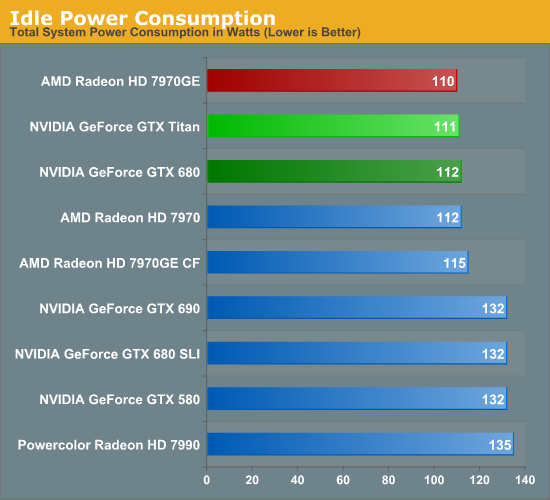
Starting as always with a look at power, there’s nothing particularly out of the ordinary here. AMD and NVIDIA have become very good at managing idle power through power gating and other techniques, and as a result idle power has come down by leaps and bounds over the years. At this point we still typically see some correlation between die size and idle power, but that’s a few watts at best. So at 111W at the wall, Titan is up there with the best cards.
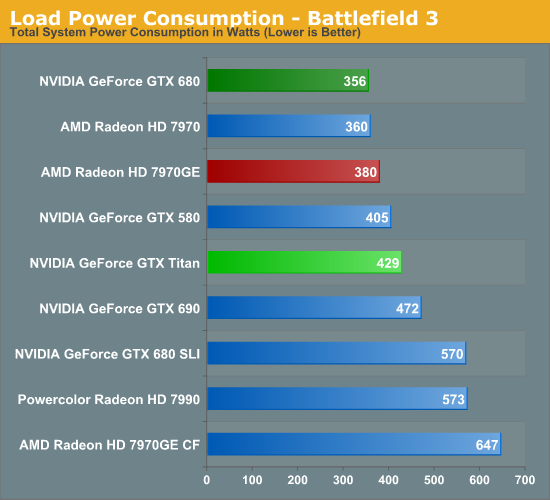
Moving on to our first load power measurement, as we’ve dropped Metro 2033 from our benchmark suite we’ve replaced it with Battlefield 3 as our game of choice for measuring peak gaming power consumption. BF3 is a difficult game to run, but overall it presents a rather typical power profile which of all the games in our benchmark suite makes it one of the best representatives.
In any case, as we can see Titan’s power consumption comes in below all of our multi-GPU configurations, but higher than any other single-GPU card. Titan’s 250W TDP is 55W higher than GTX 680’s 195W TDP, and with a 73W difference at the wall this isn’t too far off. A bit more surprising is that it’s drawing nearly 50W more than our 7970GE at the wall, given the fact that we know the 7970GE usually gets close to its TDP of 250W. At the same time since this is a live game benchmark, there are more factors than just the GPU in play. Generally speaking, the higher a card’s performance here, the harder the rest of the system will have to work to keep said card fed, which further increases power consumption at the wall.
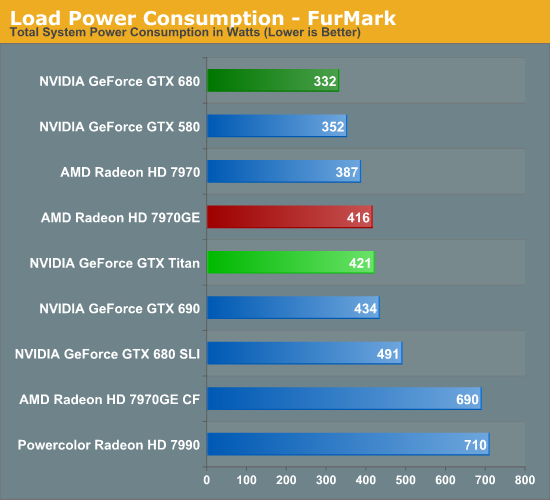
Moving to Furmark our results keep the same order, but the gap between the GTX 680 and Titan widens, while the gap between Titan and the 7970GE narrows. Titan and the 7970GE shouldn’t be too far apart from each other in most situations due to their similar TDPs (even if NVIDIA and AMD TDPs aren’t calculated in quite the same way), so in a pure GPU power consumption scenario this is what we would expect to see.
Titan for its part is the traditional big NVIDIA GPU, and while NVIDIA does what they can to keep it in check, at the end of the day it’s still going to be among the more power hungry cards in our collection. Power consumption itself isn’t generally a problem with these high end cards so long as a system has the means to cool it and doesn’t generate much noise in doing so.
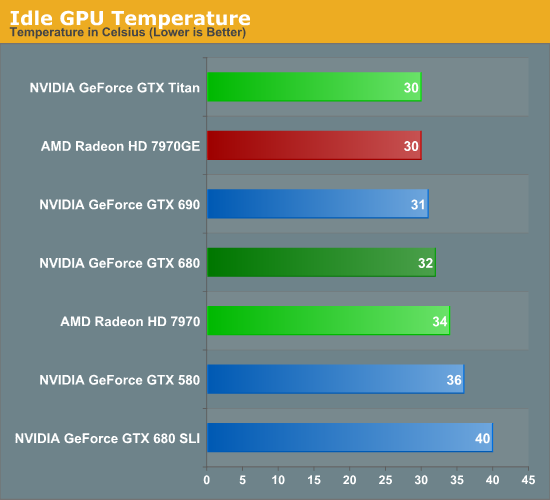
Moving on to temperatures, for a single card idle temperatures should be under 40C for anything with at least a decent cooler. Titan for its part is among the coolest at 30C; its large heatsink combined with its relatively low idle power consumption makes it easy to cool here.
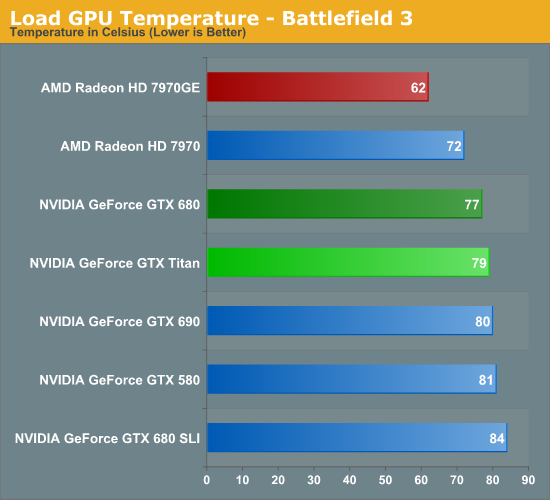
Because Titan’s boost mechanisms are now temperature based, Titan’s temperatures are going to naturally gravitate towards its default temperature target of 80C as the card raises and lowers clockspeeds to maximize performance while keeping temperatures at or under that level. As a result just about any heavy load is going to see Titan within a couple of degrees of 80C, which makes for some very predictable results.
Looking at our other cards, while the various NVIDIA cards are still close in performance the 7970GE ends up being quite a bit cooler due to its open air cooler. This is typical of what we see with good open air coolers, though with NVIDIA’s temperature based boost system I’m left wondering if perhaps those days are numbered. So long as 80C is a safe temperature, there’s little reason not to gravitate towards it with a system like NVIDIA’s, regardless of the cooler used.
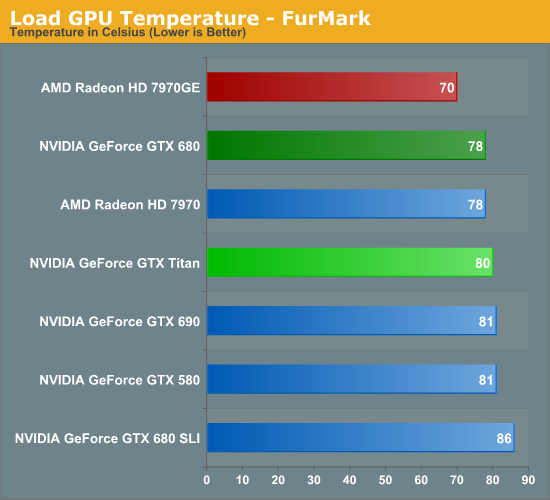
With Furmark we see everything pull closer together as Titan holds fast at 80C while most of the other cards, especially the Radeons, rise in temperature. At this point Titan is clearly cooler than a GTX 680 SLI, 2C warmer than a single GTX 680, and still a good 10C warmer than our 7970GE.

Just as with the GTX 690, one of the things NVIDIA focused on was construction choices and materials to reduce noise generated. So long as you can keep noise down, then for the most part power consumption and temperatures don’t matter.
Simply looking at idle shows that NVIDIA is capable of delivering on their claims. 37.8dB is the quietest actively cooled high-end card we’ve measured yet, besting even the luxury GTX 690, and the also well-constructed GTX 680. Though really with the loudest setup being all of 40.5dB, none of these setups is anywhere near loud at idle.
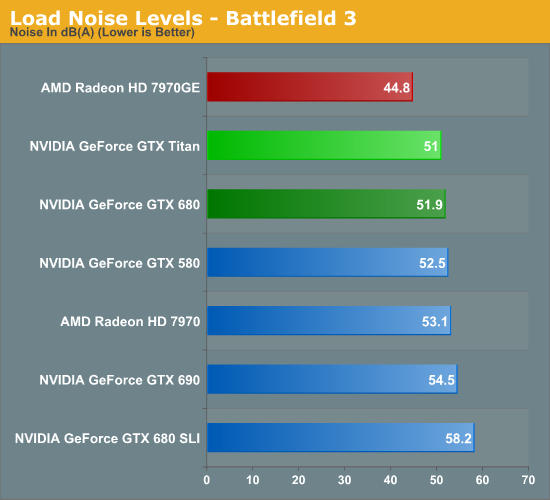
It’s with load noise that we finally see the full payoff of Titan’s build quality. At 51dB it’s only marginally quieter than the GTX 680, but as we recall from our earlier power data, Titan is drawing nearly 70W more than GTX 680 at the wall. In other words, despite the fact that Titan is drawing significantly more power than GTX 680, it’s still as quiet as or quieter than the aforementioned card. This coupled with Titan’s already high performance is Titan’s true power in NVIDIA’s eyes; it’s not just fast, but despite its speed and despite its TDP it’s as quiet as any other blower based card out there, allowing them to get away with things such as Tiki and tri-SLI systems with reasonable noise levels.
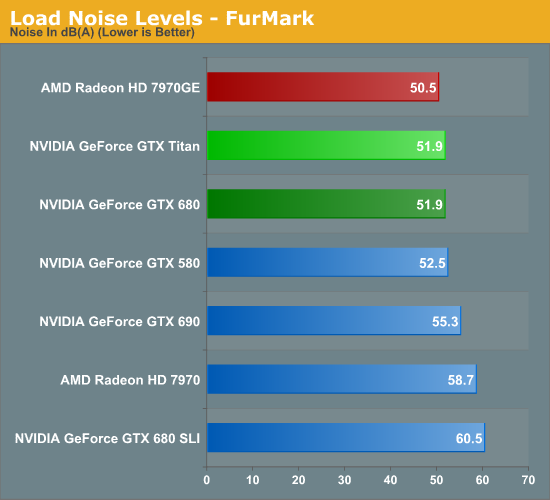
Much like what we saw with temperatures under Furmark, noise under Furmark has our single-GPU cards bunching up. Titan goes up just enough to tie GTX 680 in our pathological scenario, meanwhile our multi-GPU cards start shooting up well past Titan, while the 7970GE jumps up to just shy of Titan. This is a worst case scenario, but it’s a good example of how GPU Boost 2.0’s temperature functionality means that Titan quite literally keeps its cool and thereby keeps its noise in check.
Of course we would be remiss to point out that in all these scenarios the open air cooled 7970GE is still quieter, and in our gaming scenario by actually by quite a bit. Not that Titan is loud, but it doesn’t compare to the 7970GE. Ultimately we get to the age old debate between blowers and open air coolers; open air coolers are generally quieter, but blowers allow for more flexibility with products, and are more lenient with cases with poor airflow.
Ultimately Titan is a blower so that NVIDIA can do concept PCs like Tiki, which is something an open air cooler would never be suitable for. For DIY builders the benefits may not be as pronounced, but this is also why NVIDIA is focusing so heavily on boutique systems where the space difference really matters. Whereas realistically speaking, AMD’s best blower-capable card is the vanilla 7970, a less power hungry but also much less powerful card.










337 Comments
View All Comments
CeriseCogburn - Tuesday, February 26, 2013 - link
I really don't understand that mentality you have. I'm surrounded by thousands of dollars of computer parts and I certainly don't consider myself some sort of hardware enthusiast or addicted overclocker, or insane gamer.Yet this card is easily a consideration, since several other systems have far more than a thousand dollars in them on just the basics. It's very easy to spend a couple thousand even being careful.
I don't get what the big deal is. The current crop of top end cards before this are starkly inadequate at common monitor resolutions.
One must nearly ALWAYS turn down features in the popular benched games to be able to play.
People just don't seem to understand that I guess. I have untold thousands of dollars in many computers and the only thing that will make them really gaming capable at cheap monitor resolutions is a card like this.
Cripes my smartphone cost a lot more than the former top two cards just below Titan.
This is the one area that comes to mind ( the only one that exists as far as I can tell) where the user is left with "my modern computer can't do it" - and that means, take any current taxing game (lots of those - let's say 50% of those reviewed as a rough thumb) and you're stuck unable to crank it up.
Now 120hz monitors are becoming common, so this issue is increased.
As you may have noticed, another poster exclaimed:
" Finally ! 1920x1080 a card that can do it ! "
There's the flat out closest to the truth, and I agree with that entirely, at least for this moment, as I stated here before the 7970 didn't do it when it was released and doesn't now and won't ever. (neither does the 680)
I'm trying to deny it, but really it is already clear that the Titan doesn't cut it for everything at the above rez either, not really, and not at higher refresh rates.
More is still needed, and this is the spot that is lacking for gamers, the video card.
This card is the card to have, and it's not about bragging, it's about firing up your games and not being confronted with the depressing "turn off the eyecandy" and check the performance again... see if that is playable...
I mean ****, that apparently does not bother any of you, and I do not know why.
Everything else in your system is capable...
This is an IMPORTANT PART that actually completes the package, where the end user isn't compromising.
HighTech4US - Thursday, February 21, 2013 - link
If it does could we see a new story on performance using NVENC across the entire Kepler line along with any FREEware/PAYware software that utilizes it. I have an older Intel Q8300 that is used as my HTPC/Living Room Gaming System and encoding videos take a long time just using the CPU cores.If getting a Kepler GPU and using NVENC can speed up encoding significantly I would like to know. As that would be the lowest cost upgrade along with getting a Gaming card upgrade.
Thanks
Ryan Smith - Thursday, February 21, 2013 - link
Yes, NVEnc is present.lkuzmanov - Thursday, February 21, 2013 - link
excellent! now make it 30-40% cheaper and I'm on board.Zink - Thursday, February 21, 2013 - link
Rahul Garg picked the lowest HD 7970 scores in both cases from the Matsumoto et al. paper. The other higher GFLOPS scores represent performance using alternate kernels performing the same calculation on the same hardware as far as I can tell. Rahul needs to justify choosing only the lowest HD 7970 numbers in his report or I can only assume he is tilting the numbers in favor of Titan.JarredWalton - Thursday, February 21, 2013 - link
Picking the highest scoring results that are using optimized cores and running on different hardware in the first place (e.g. not the standard test bed) would be tilting the results very far in AMD's favor. A default run is basically what Titan gets to do, so the same for 7970 would make sense.codedivine - Thursday, February 21, 2013 - link
The different algorithms are actually not performing the exact same calculation. There are differences in matrix layouts and memory allocations. We chose the ones that are closest to the layouts and allocations we were testing on the Titan.In the future, we intend to test with AMD's official OpenCL BLAS. While Matsumoto's numbers are good for illustrative purposes. We would prefer running our own benchmarks on our own testbeds, and on real-world code which will typically use AMD's BLAS for AMD cards. AMD's OpenCL BLAS performance is actually a little bit lower than Matsumoto's numbers so I don't think we tilted the numbers in AMD's favour. If anything, we gave AMD a bit of benefit-of-the-doubt here.
In the same vein, faster results than Nvidia's CUBLAS have been demonstrated on Nvidia hardware. However, we chose to test only using CUBLAS as all production code will typically use CUBLAS due to its reliability and support from Nvidia.
AMD's OpenCL BLAS is a bit complicated to setup correctly and in my research, I have had problems with stability with it on Windows. Thus, we avoided it in this particular review but we will likely look at it in the future.
Zink - Thursday, February 21, 2013 - link
Thanks, shouldn't have doubted you :)Nfarce - Thursday, February 21, 2013 - link
...about my 680 purchase last April (nearly a year ago already, wow). Was so worried I made the wrong decision replacing two 570s knowing the Kepler was less than a year away. The news on this card has firmed up my decision to lock in with a second 680 now for moving up to a 2560x1440 monitor.Very *very* disappointing, Nvidia.
CeriseCogburn - Thursday, February 21, 2013 - link
The new top card has been near the same as two of the former cards FOREVER.You people are nothing short of stupid nut jobs.
There are not enough tampons at Johnson and Johnson warehouses for this thread.
THE VERY SAME RATIO has occurred every time for all the prior launches.